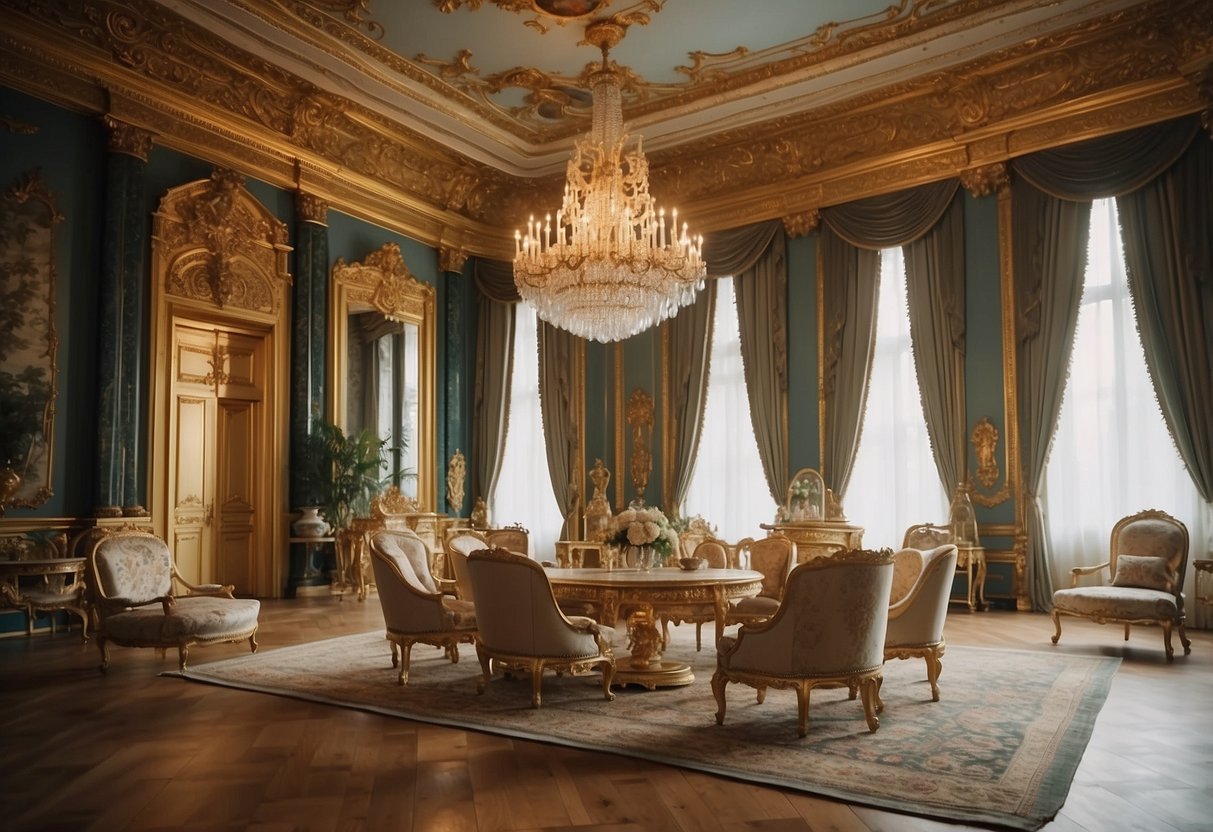Introduction
When we think of Catherine the Good, the Empress of Russia, we often envision her as a robust monarch who widened the European Empire, catherine the great furniture produced enlightenment to Russia, and fostered the flourishing of arts and culture. But, one of the very most lasting legacies of her reign lies in her influence on inside style, particularly through the well-known “Catherine the Good furniture.”
Catherine was not just a leader but also a passionate client of the arts. She had a willing attention for style, beauty, and refinement, all of which were reflected in the furniture parts that explained her court and palaces. These pieces—highly adorned with catherine the great furniture magnificent products and showcasing elaborate craftsmanship—are now adored as designs that embody the opulence of her time.
In this article, we shall explore the position of Catherine the Good in transforming European inside style, the two major furniture styles she championed—Rococo and Neoclassicism—and how her influence continues to resonate in contemporary inside design. Let’s jump in to the world of “Catherine the Good furniture” and discover the amazing style that also captivates inside manufacturers, lovers, and historians alike.
The Role of Catherine the Great in Russian Interior Design
Catherine the Great’s reign (1762–1796) noted an important amount of social and creative transformation in Russia. Her influence on the arts and inside style was profound, catherine the great furniture as she was deeply devoted to taking European culture to Russia. This involved commissioning grand furniture parts that reflected the newest styles in European art and design.
Before Catherine’s reign, European interiors were easy, with furniture primarily manufactured from timber, often unadorned. But, below her patronage, European palaces and elegant residences, like the famous Catherine Palace in Tsarskoye Selo, turned centers of grandeur. Catherine embraced the European types of the 18th century, specially Rococo and Neoclassicism, equally of of reflected in the furniture of the time.
Catherine’s personal choice for superior, luxurious, and ornamental furniture played a huge position in surrounding the magnificent aesthetic of the European court. The furniture she commissioned wasn’t merely practical but also made to reveal her very catherine the great furniture own polished choices and Russia’s growing prestige on the European stage. Furniture in her court turned a mark of status, and she spared number expense in commissioning parts that were equally lovely and opulent.
Catherine the Great Furniture Styles: Rococo Meets Neoclassicism
One of the defining features of Catherine the Good furniture may be the mixture of two outstanding styles—Rococo and Neoclassicism. Equally styles have distinctive characteristics, yet they reveal a standard gratitude for beauty, style, and craftsmanship.
Rococo Furniture: Elegance and Ornamentation
Rococo furniture appeared in France all through catherine the great furniture the early 18th century and turned the principal design in Europe all through Catherine the Great’s time. This design is characterized by its exuberance, elaborate detailing, and fluid forms. Rococo furniture often included asymmetrical forms, rounded lines, and ornate carvings. Gilded finishes and magnificent products like silk, velvet, and fine woods were common.
For Catherine, Rococo displayed complexity and refinement. Her fondness for this design is evident in several parts within the palaces of St. Petersburg, particularly in the decoration of rooms like the famous “Rococo Room” in the Catherine Palace. Furniture out of this period often involved fine mirrors, elaborate units, and ornamental seats, all adorned with gold leaf, floral motifs, and curvaceous legs.
Neoclassicism: A Come back to Traditional Simplicity
While Rococo embraced surplus and ornamentation, Neoclassicism, which appeared later in the 18th century, favored more restrained and balanced types influenced by the traditional art and architecture of ancient Greece and Rome. Neoclassical furniture highlighted straight lines, symmetry, and a feeling of buy, integrating motifs such as for example columns, catherine the great furniture laurel wreaths, and Greek and Roman-inspired designs.
Catherine’s curiosity about Neoclassicism was partly pushed by her admiration for Enlightenment a few ideas and the influence of French philosophers. As a result, she embraced furniture that mixed equally grandeur and simplicity. Neoclassical parts commissioned all through her reign often involved elegant seats with straight, fluted legs, tough platforms, and catherine the great furniture intricately developed tables, all echoing the dignity of traditional antiquity.
The combination of Rococo’s exuberance and Neoclassicism’s ease can be seen in lots of Catherine’s furniture commissions. The mix of those styles not merely elevated European court style but also situated Catherine as an enlightened leader who valued both the opulence of the past and the intellectual action of her time.
Notable Features of Catherine the Great Furniture
Catherine the Good furniture is notable by a few notable functions which make it straight away familiar and very desirable. The quality, style components, and products applied all through her reign collection a brand new common for furniture-making in Russia and beyond.
Complicated Carvings and Gilding
Several pieces of Catherine the Good furniture are notable by their intricate carvings. These could range between fine floral designs to elaborate views from catherine the great furniture traditional mythology. Gilding was another outstanding feature, with gold leaf or gold color applied to spotlight the curves and ends of the furniture, putting a little grandeur.
Magnificent Products
Catherine’s furniture was constructed applying the finest products available at the time. Rich woods like pine, mahogany, and rosewood were typically applied, often finished with intricate veneers. Upholstery was done in fine silks, velvets, and brocades, often catherine the great furniture in colors of pale pinks, blues, and gold, in line with the Rococo aesthetic. Neoclassical parts, while simpler, still included high-quality products that exuded elegance.
Elegance and Functionality
Whilst the furniture of Catherine the Great’s time was ornamental, in addition, it served useful purposes. Chairs, platforms, and tables were carefully developed catherine the great furniture to ensure equally comfort and application while sustaining their magnificent appearance. For example, Catherine’s writing tables weren’t only lovely but also very practical, highlighting her intellectual pursuits.
Famous Examples of Catherine the Great Furniture
Some of the very most famous pieces of Catherine the Good furniture have become catherine the great furniture well-known designs of the era. A number of these parts are housed in museums, such as the State Hermitage Museum in St. Petersburg, wherever visitors may admire their artistry and craftsmanship.
- The Catherine Palace Furniture: The rooms of Catherine the Great’s palace in Tsarskoye Selo are a sensational show of furniture which was equally commissioned and influenced by her. The “Catherine Space,” adorned with Rococo furniture, illustrates the elaborate digging and gilded finishes characteristic of this style.
- The Pavlovsk Palace Furniture: Catherine’s boy, Emperor Paul I, commissioned furniture for the Pavlovsk Palace that reflected a more restrained Neoclassical style. These parts, which are now housed in the Pavlovsk Museum, spotlight the shift from Rococo to Neoclassicism all through Catherine’s later years.
Catherine the Great’s Influence on Modern Interior Design
Catherine the Good furniture continues to encourage modern manufacturers and collectors. The influence of Rococo and Neoclassical furniture is evident in contemporary interiors, wherever parts that evoke the style of the 18th century are increasingly being incorporated in to properties and luxury spaces.
Interior manufacturers nowadays often pull motivation from Catherine’s love for symmetry and buy in Neoclassical parts, while also adopting the playfulness and opulence of Rococo designs. The usage of gold decorations, magnificent products, and detailed carvings can be seen in equally modern furniture style and inside decor.
Maintaining and Preserving Catherine the Great Furniture
Provided this and value of “Catherine the Good furniture,” care and preservation are necessary for sustaining these treasures. Classic furniture needs careful handling to ensure its longevity. Standard washing, preventing direct sunlight, and managing humidity are very important measures in sustaining the strength of those important pieces.
Repair professionals often work with these antiques to maintain their historical value while sustaining the reliability of the design. Whether it’s fixing a piece to its original state or sustaining its problem, care guarantees that these superb pieces of history continue being enjoyed for generations.
Conclusion
Catherine the Great’s furniture remains a testament to her perspective and influence over European art and culture. The mix of Rococo’s original beauty and Neoclassicism’s traditional style made furniture which was not merely practical but also a mark of grandeur and sophistication. Whether in palaces, museums, or individual choices, “Catherine the Good furniture” continues to captivate lovers, historians, and inside manufacturers alike. These parts embody a minute in history when art, culture, and elegant power got together in great harmony.
FAQs about Catherine the Great Furniture
1. What type of furniture did Catherine the Good choose?
Catherine the Good preferred magnificent and intricate furniture, integrating equally Rococo and Neoclassical styles. Her furniture included elaborate carvings, gilded finishes, and magnificent products such as for example silk and velvet.
2. How come Catherine the Good furniture therefore important nowadays?
Catherine the Good furniture is very respected because of its historical significance, extraordinary quality, and the magnificent products used in its construction. These parts are considered amazing artwork that represent the level of 18th-century European style.
3. Just how can I incorporate Catherine the Good furniture in contemporary interiors?
To include Catherine the Good furniture in to contemporary interiors, consider blending magnificent, ornate parts with simpler, modern furniture. Give attention to key elements like gilded finishes, elegant carvings, and shaped designs to bring the opulence of the past in to today’s homes.
4. Wherever may I find real Catherine the Good furniture?
Traditional Catherine the Good furniture is found in prestigious museums like the Hermitage Museum in St. Petersburg or through reputable vintage retailers focusing on European antiques. Lovers also find parts at high-end auctions.











Leave a Reply